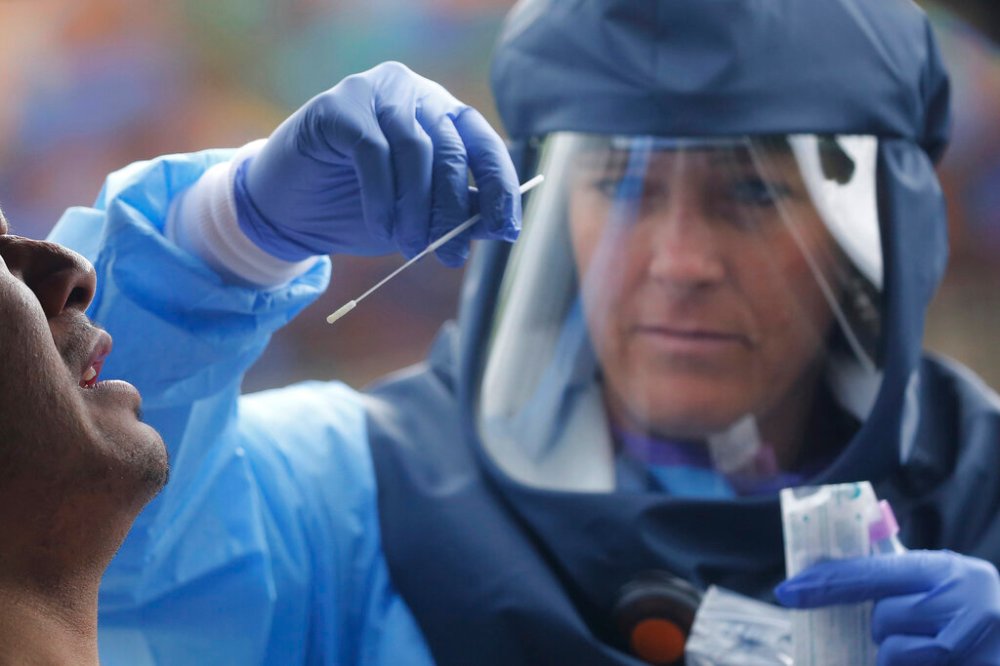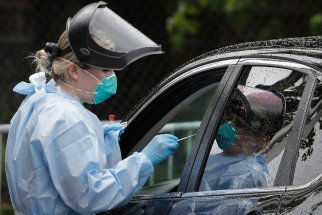Little value in widespread testing without symptoms, health officials say
Read this article for free:
or
Already have an account? Log in here »
To continue reading, please subscribe:
Monthly Digital Subscription
$0 for the first 4 weeks*
- Enjoy unlimited reading on winnipegfreepress.com
- Read the E-Edition, our digital replica newspaper
- Access News Break, our award-winning app
- Play interactive puzzles
*No charge for 4 weeks then price increases to the regular rate of $19.00 plus GST every four weeks. Offer available to new and qualified returning subscribers only. Cancel any time.
Monthly Digital Subscription
$4.75/week*
- Enjoy unlimited reading on winnipegfreepress.com
- Read the E-Edition, our digital replica newspaper
- Access News Break, our award-winning app
- Play interactive puzzles
*Billed as $19 plus GST every four weeks. Cancel any time.
To continue reading, please subscribe:
Add Free Press access to your Brandon Sun subscription for only an additional
$1 for the first 4 weeks*
*Your next subscription payment will increase by $1.00 and you will be charged $16.99 plus GST for four weeks. After four weeks, your payment will increase to $23.99 plus GST every four weeks.
Read unlimited articles for free today:
or
Already have an account? Log in here »
Hey there, time traveller!
This article was published 11/06/2020 (2009 days ago), so information in it may no longer be current.
As Manitoba further loosens COVID-19 restrictions, officials are not planning a wide-scale, proactive effort to randomly test people without symptoms.
The province is undertaking random tests of people in high-risk workplaces, but isn’t tapping its full capacity for testing.
Instead, officials say focusing on those with symptoms is the best way to stamp out the coronavirus.
“Certainly, the value of testing symptomatic people is much higher than testing asymptomatic people,” said Dr. Brent Roussin, Manitoba’s chief public health officer.
“We’re certainly not turning away people who show up for testing, but we’re not encouraging just the average Manitoban to come, if they’re not having symptoms.”
Premier Brian Pallister pledged on April 28 that Manitoba will have the capacity to test up to 3,000 people per day by the end of summer, though the number of tests in any given week has ranged from 217 to 887 per day.
For months, Manitoba allowed only those with symptoms to get tested. On May 20, the province started to allow asymptomatic people to be tested, and started “sentinel surveillance,” which involves testing people who are visiting health-care centres for other reasons, to see if undetected community spread is underway.
Officials have also targeted testing of asymptomatic people whose work regularly takes them outside the province.

That includes cross-border truck drivers, whose recent cases in Manitoba and other provinces prompted the federal NDP to ask for mandatory testing at the border.
Roussin said his team offered to establish testing sites at truck stops, but decided not to do so after consulting an industry association. He said the province is “still having ways to search for and pick up community transmission.”
His federal counterpart, Dr. Theresa Tam, said Thursday that Canada’s top doctors have largely kept asymptomatic testing limited to people living in close quarters where a case has emerged, such as long-term care homes and jails.
They’re now conducting various pilot projects, sometimes through mobile testing clinics “so we can jump on the cases, trace contacts and eliminate any sparks of chains of transmission,” Tam told the Free Press.
“There are active discussions as to how do we provide that testing more widely, recognizing that some of the workers may not recognize symptoms, may be living in crowded conditions, may also be worried about disclosing their symptoms as well,” she said, citing migrant workers as an example.
Back before provinces started opening up, Prime Minister Justin Trudeau highlighted the importance of widespread testing.
“We’re going to be need to be extremely vigilant, extremely prepared to respond quickly with massive testing,” Trudeau said on April 16.
However, Amir Attaran, an outspoken public-health professor at the University of Ottawa, is critical of the Public Health Agency of Canada for only offering guidance to provinces, instead of mandating a national testing standard.

“One of Canada’s biggest failures is we don’t have a national testing strategy, and this is a colossal failure of the Trudeau government,” Attaran said, arguing that developing countries have better co-ordination.
The tracking site Worldometer ranks Canada at 41st in the world in tests per million population.
“How precisely is Canada going to open the border with the United States, or any other country in the world, if it does not have testing and contact tracing across the entire country that it can be confident in?”
Roussin’s predecessor, Dr. Joel Kettner, cautioned against testing everybody in the population, and not just because of the risk of false negatives.
“(Testing) is a complex public-health question that requires a lot of nuanced considerations,” said Kettner, a University of Manitoba public-health professor.
The province’s goal has been reducing both deaths and the risk of overburdening the health system. Kettner said entirely eliminating the coronavirus would come at a much higher cost.
He said healthy people who get mild cases of COVID-19 and won’t require hospitalization can recover at home and build some immunity, though researchers are still trying to determine to what degree.
Kettner believes that might be better than forcing all the friends and co-workers of a person who had asymptomatic COVID-19 into isolation and out of work for two weeks, given the cumulative psychological impact of that separation.
He fears that prospect would be a disincentive for COVID-19 carriers from actually naming everyone they’ve come into contact with.
“If asymptomatic people are transmitting the disease, it’s probably a very small proportion of the cases that we have. And if they do, it’s probably because of very close contact they’ve had with somebody; not just being in the same room or standing a foot away, if they’re not coughing or sneezing,” said Kettner.
He argued it would be better to isolate those with risk factors and provide them with economic and psychological support.
“If (testing and isolating asymptomatic carries) doesn’t interrupt transition to high-risk people — because of their age and health conditions — then I don’t see the benefit of it,” he said, suggesting kids could return to school, but not touch their live-in grandparents.
dylan.robertson@freepress.mb.ca
History
Updated on Thursday, June 11, 2020 7:06 PM CDT: Adds chart







